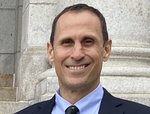

Every community in the United States needs local news. But today, over 70 million Americans live in a county with no newspapers or only one, according to a report by the Medill Local News Initiative. That’s over 1,700 counties of 3,143 counties in the nation. In other words, more than half the country is a news desert.
A better future for journalism has no news deserts in the U.S. Every resident has access to quality news and information about their communities. This means creating at least 340 new local news organizations a year for the next five years.
It’s an ambitious goal, but it is possible with support from a diverse media ecosystem of partners. The future of a democratic society depends on finding a better way to do journalism.
This media ecosystem can be built from the ground up, amplifying what’s working in journalism and local news. We need to focus on what’s strong, not what’s wrong, to create an ecosystem of support that promotes a diverse new generation of news ownership. By creating an equitable future for journalism, we can create an equitable future for everyone.
Ending news deserts can help restore trust in journalism, and local news can help get journalism on this path. It’s no secret that public trust in the media has fallen to historic lows. Americans have lost faith in the news. One of the biggest reasons so many Americans distrust the media is the decline of local news.
Local news helps people understand what is happening in their community and how it impacts them, their families and friends. Local news builds trust. Local news builds community. Local news is essential to having a strong and healthy community.
Without local news, people turn to social media and news sources outside their community. These other sources outside the community can blur the lines between news and opinion, present biased news coverage, and produce misleading stories that don’t present all the facts, or tell the whole story.
Less local news has led to reduced civic engagement, less accountability for government, more corruption, more partisanship, and more polarization. When people have access to local news about their community, they think like locals. When they rely on news sources outside their community, they think along party lines.
We are fortunate to have many local news sources in Minneapolis, but other communities don’t have that luxury or benefit.
In our brave new world of journalism, every American will have access to credible and comprehensive news and information about their communities. Every local news organization will be owned by people who represent the communities they serve and uphold the highest ideals of journalism.
These local newsrooms will be run by a small, innovative team of professional journalists and be a true collaboration with the community. Community members can pitch story ideas, submit stories, and report news with training and support from the newsroom.
Each local news organization will generate revenue through events, memberships, sponsorships, donations, advertising and grants. And everyone will be paid for their work.
Investing in local news can create well-functioning communities with more opportunities for the whole community. The end result is community problems turn into community solutions.
To assist in restoring the credibility of journalism and its reputation as a noble calling, schools, starting in middle school, will have youth journalism programs with digital news services run by students. Professional journalists, including those who have lost journalism jobs in the last decade, can oversee the programs. Philanthropies, local agencies, community members and businesses will fund the programs.
Local news organizations will provide journalism micro-internships to local students to give youth “first job” opportunities and inspire them to create positive change in their communities.
More local news helps restore trust in journalism. Trust leads to understanding. Understanding leads to humanity. And humanity unites us all.
There are journalism and media organizations that are doing this kind of work. They have built the foundation and infrastructure to help communities build sustainable news organizations and reshape the media landscape from the ground up. They just have to scale operations to help more news deserts become news communities, connect them all, and create a national collaborative network of mutual support.
This collaborative network will include news organizations, journalists, and academic institutions. Everyone will be committed to building a sustainable local news ecosystem through collaboration, innovation, and education. Partners will include foundations, philanthropies, public institutions, private companies, individuals, and other organizations that share the same values. They will provide funding, expertise, and other resources to help advance the shared mission.
There is no single solution to end local news deserts, but this media ecosystem could help reverse the loss of local news. It starts by building newsrooms in every local news desert, one community at a time.
Comments
No comments on this item Please log in to comment by clicking here